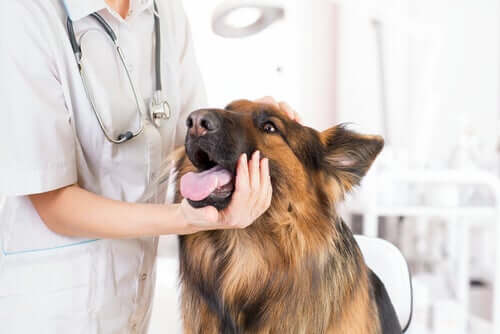The Most Common Skin Conditions in Dogs


Written and verified by the lawyer Francisco María García
Those of us who keep dogs as pets are familiar with the symptoms associated with their skin conditions because we’ve all seen them at some point. Such is the case with allergies, itching, and irritation. These symptoms could be due to insect bites, or a reaction to certain foods, substances, etc.
Parasites are a common cause of skin conditions in dogs. Also, fleas and ticks are the most frequent parasites who invade our pets’ skin. Furthermore, they’re the source of various dermatological problems, such as dermatitis.
When a flea bites a dog it causes the sort of itching that leads to compulsive scratching. In turn, this continuous scratching leads to inflammation and skin redness.
In addition to irritated skin, fleas and ticks can also produce serious parasitic infections in your dog such as ehrlichiosis. The solution to this problem is to keep these parasites under control by using specific, effective products formulated for dogs. Also, make sure such products are dog-friendly and won’t damage their skin any further.
Allergies and skin conditions

Food allergies and external agents are other frequent sources of skin symptoms such as irritation, small blemishes, and reddened areas. For example, pollen affects dogs as much as it affects people.
Accidents in the home
In addition, things such as accidents in the home, extreme sun exposure, street abuse, and fights with other dogs could also have consequences for a dog’s skin.
Of course, if your furry friend lives inside your home, then keep in mind the risks that are present in areas such as the kitchen. This is the room where most dogs, and puppies in particular, are victims of careless accidents that lead to burns, cuts, and accidents that cause damage to their skin.
Tumors and cysts
Cancerous tumors are another form of skin condition that may affect a dog. In particular, they may arise in the form of carcinoma, sebaceous cysts, adenomas (which are similar to warts), and melanomas (skin spots).
The older the dog, the greater their propensity to suffer from this type of skin conditions.
Some internal diseases could also affect a dog’s skin
Some metabolic disorders, such as diabetes, also have an impact on the health of a dog’s skin. When a vital organ of their body, such as the liver, is afflicted by disease, then it reflects on the skin through changes in its color and texture.
Other types of metabolic disorders such as Cushing’s Syndrome and hyperthyroidism also have an impact on the health of a dog’s skin. These symptoms appear as ulcers, sores, and slow healing of wounds.
Prevention and treatments for skin conditions
The consequences of skin conditions usually show up as inflammation, accumulation of fluid or fat in specific spots, redness, and/or darkening of the skin. These require specific treatments and a vet will determine them on a case by case basis and degree of severity.
Certain foods that are rich in fatty acids, as well as some compound feeds and hypoallergenic foods, could also help a dog with skin problems. However, keep in mind that proper hygiene is also very important.
Furthermore, depending on the type and severity of an injury, treatment may involve antiseptics, dressings, antibiotics or anti-inflammatory ointments.
Tips to heal your dog’s skin
- De-worming is very important to a dog. This is the best way to avoid the harmful effects of fleas and ticks.
- Excess water and/or bathing is not advisable, and so its frequency, using only products that are appropriate, should be well timed. Among other things, because it could damage the animal’s skin and lead to pH imbalances.
- Poorly healed wounds are also a gateway for skin infections. So, you should keep them clean and try to keep the dog from licking them.
Bacterial skin conditions in dogs
Fungal infections
These arise from a fungal invasion and almost always start under the animal’s claws and between the legs, extending later throughout their entire body.
Ringworm

This infectious and contagious disease caused by a fungus could also infect humans.
One of its symptoms is the appearance of small bald spots on the skin of an animal; it spreads very quickly and leads to itching.
Pyoderma gangrenosum
These are a series of bacterial skin infections that appear on a dog’s skin. There are many symptoms, ranging from small bumps to pustules that secrete pus, and there may or may not be hair loss in the affected areas.
Skin conditions and cancer
Cancer is another condition that may affect a dog’s skin. Its symptoms may present as general redness, skin rashes, hair loss, etc.
This text is provided for informational purposes only and does not replace consultation with a professional. If in doubt, consult your specialist.